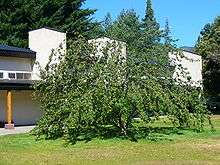Balseiro Institute
| Instituto Balseiro | |
|
| |
| Type | Research Institute |
|---|---|
| Established | 1955 |
| Director | Dr. Carlos A. Balseiro [1] |
Administrative staff | 80 |
| Students | 160 |
| Undergraduates | 90 |
| Location | Bariloche, Río Negro, Argentina |
| Website |
www |
| Infobox data sourced from the Institute’s website. | |
Balseiro Institute (Spanish: Instituto Balseiro) is an academic institution chartered by the National University of Cuyo and the National Atomic Energy Commission. It is located in Bariloche, Río Negro province, Argentina. The Instituto Balseiro has become a centre of world-class science. Its character and creativity, however, are distinctly Latin American.[2] Distinguished physicists, such as Marcela Carena, Juan Maldacena, and Jorge Pullin have studied at this institute.
Overview


The Balseiro Institute teaches Physics, Nuclear Engineering, Mechanical Engineering and Telecommunications Engineering at undergraduate and graduate levels. The institute admits students who have completed two years of university studies (either in Physics or Engineering) and undergoes a rigorous admission procedure.
It's considered the best Experimental Physics and Nuclear Engineering study centres of Latin America, as well as a very prestigious one worldwide.
History
Nuclear research in the province of Rio Negro began as the Huemul Project in the Perón era. Nuclear facilities were organized as the Bariloche Atomic Centre, under the direction of José Antonio Balseiro.
An educational institution was established as the Instituto de Física de Bariloche on April 22, 1955, as a joint project of the National Atomic Energy Commission and the National University of Cuyo; the former administers the Bariloche Atomic Centre, whose work led to the first research reactor in Latin America (1957), as well as the region's first commercial reactor, Atucha I, in 1974. The institute was renamed in 1962 to honor José Antonio Balseiro, who was its first director.
The first graduates were members of the Physics class of 1958. In the 1970s, Balseiro became the only institute in Argentina to grant degrees in nuclear engineering, as the country was stepping up its nuclear program with the incorporation of the Embalse and Atucha II, as well as continued research activity in the Constituyentes and Bariloche reactors.
See also
- INVAP
- Gregorio Baro
- Guido Beck
- Think tank#Argentina
- List of Guggenheim Fellowships awarded in 2001
- List of Guggenheim Fellowships awarded in 2007
References
- ↑ Balseiro Institute website – “Autoridades” page (accessed 2016-11-11)
- ↑ A Special Place for Global Science from TWAS.
External links
- (Spanish) Official website
- (English) / Official website
- Science and Education in Argentina
- Argentine Higher Education Official Site
Coordinates: 41°09′57″S 71°26′39″W / 41.16583°S 71.44417°W
